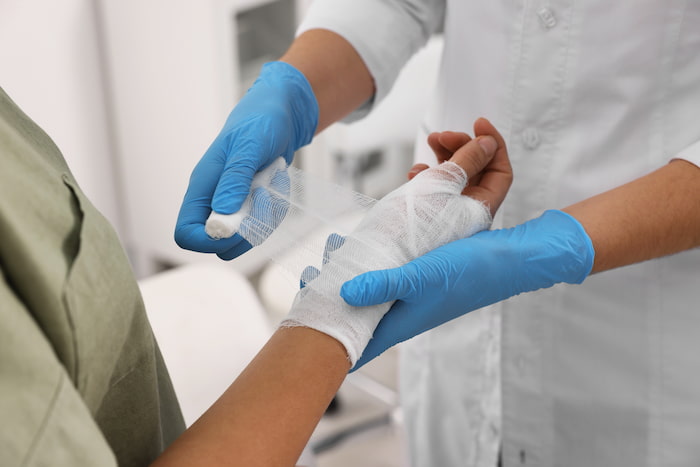
Seeking Fair Compensation For Burn Victims
Severe burn injuries are extremely painful and often lead to both physical and emotional scars. If someone else was responsible for the incident that caused your burn injuries, you should not—and do not—have to suffer the consequences on your own.
At Goldenzweig Law Group, PLLC, our Houston burn injury lawyers have nearly four decades of combined legal experience, including extensive experience handling complex catastrophic injury claims. We have seen firsthand the immense impact these injuries have on victims and their loved ones, and we know how to effectively advocate for the fair compensation they are owed. As your legal team, we will fight for you every step of the way, all while providing the personal attention, care, and support you deserve.
Continue reading to learn more, or contact us today at (713) 609-1930 to request a complimentary case evaluation with our team. Hablamos español.
Types of Burn Injuries
There are several different types of burn injuries, each of which are categorized according to severity, or “degree.”
The different types of burn injuries include:
- Thermal Burns: Thermal burns are the most common type of burn injury. They are caused by contact with hot items, surfaces, liquids, and substances.
- Friction Burns: Also known as “road rash,” a friction burn is a combination of a heat burn (or thermal burn) and an abrasion (or scrape).
- Electrical Burns: Electrical burns occur when an individual is electrocuted or otherwise comes into contact with live electrical currents.
- Radiation Burns: Various forms of radiation, including x-rays and other medical treatments, as well as solar radiation, can cause radiation burns. A sunburn is a type of radiation burn.
- Chemical Burns: These types of burn injuries are caused by contact with harsh and abrasive solvents, detergents, dyes, paint thinners, and other chemicals.
- Cold Burns: Also known as “frostbite,” cold burns refer to skin damage and the destruction of other tissue due to exposure to extreme cold.
These burn injuries are categorized according to the following degrees:
- First-Degree Burns: First-degree burns are relatively mild injuries. They affect only the outer layer of skin (epidermis) and typically do not require professional medical attention. First-degree burns may result in pain, redness, and mild scarring.
- Second-Degree Burns: Also known as partial-thickness burns, second-degree burns affect both the outer and lower layers of skin (epidermis and dermis, respectively). They may result in redness, swelling, blisters, pain, and a shiny appearance to the skin, as well as scarring.
- Third-Degree Burns: Third-degree burns are also known as full-thickness burns because they result in destruction of both the epidermis and dermis, as well as damage to surrounding tissues and nerves. Third-degree burns often lead to “charred” skin, which may be black, brown, white, or yellow in appearance.
- Fourth-Degree Burns: Fourth-degree burns are the most severe of all burn injuries in that they are the deepest and cause the most damage. These burn injuries destroy both the epidermis and dermis, as well as surrounding tissue, muscles, tendons, bones, and nerves. Fourth-degree burns may be fatal.
It is not uncommon for the severity of a burn injury to change over time. This could happen if the damage caused by the initial burn continues to spread or if the injury itself becomes deeper. Because of this, you should always seek medical treatment for a serious burn injury.
How Are Burn Injuries Treated?
The appropriate treatment depends on the type and severity of the burn injury. First-degree and milder second-degree burns can be treated with basic first aid, such as running cool water over the affected area or applying a cool, damp compress. More serious burns generally require medical intervention, and severe burn injuries may necessitate treatment in specialized burn treatment centers.
Generally speaking, the goal of burn injury treatment is to address the initial injury, prevent infection, and help victims regain function. Treatment also focuses on managing pain, limiting scarring, and removing damaged tissue (if necessary).
Some common burn treatments include:
- Dehydration prevention, often through intravenous (IV) fluids
- Ultrasound mist therapy for wound cleaning and stimulation
- Topical ointments and creams to assist in healing and pain management
- Infection prevention, often with the use of antibiotics
- Tetanus prevention, via a tetanus shot
- Anxiety and pain management, often medically assisted
- Physical therapy and rehabilitation
- Occupational rehabilitation (if necessary)
- Skin grafts, plastic surgery, and other surgical procedures
These are just some of the various types of treatments used to address different types of burn injuries. The exact treatment you may need will depend on the type of burn you have suffered, the location and surface area of the burn, and its severity, among other factors.
Preventing Burn Injuries: Tips for Home and Workplace Safety
At Goldenzweig Law Group, PLLC, we believe that prevention is always better than cure. That’s why we want to provide you with some helpful tips to prevent burn injuries in your home and workplace. By following these safety measures, you can reduce the risk of burn accidents and protect yourself and your loved ones:
Home Safety Tips:
- Always supervise children in the kitchen and keep them away from hot surfaces and appliances.
- Install smoke alarms and carbon monoxide detectors throughout your home and test them regularly.
- Keep flammable objects such as curtains, towels, and clothing away from open flames and heat sources.
- Use caution when cooking with hot oil and never leave the stove unattended.
- Set your water heater temperature to a safe level to avoid scalding.
Workplace Safety Tips:
- Follow all safety protocols and guidelines provided by your employer.
- Wear appropriate protective clothing and equipment when working with heat or chemicals.
- Ensure that fire extinguishers are easily accessible and regularly inspected.
- Report any potential fire hazards or faulty equipment to your supervisor immediately.
- Participate in fire safety training and know the evacuation plan for your workplace.
By implementing these safety measures, you can create a safer environment for yourself and those around you. However, accidents can still happen, and if you or a loved one has suffered a burn injury due to someone else’s negligence, our team of Houston burn injury lawyers is here to help.
Contact us today at (713) 609-1930 for a free consultation to discuss your legal options and seek fair compensation for your injuries.
Compensation for Burn Injury Victims
Many burn injuries are the result of preventable accidents and incidents that occur only because someone else behaved negligently or wrongfully. When this is the case, burn victims and/or their loved ones may be entitled to financial compensation for their economic and non-economic damages.
Some examples of common damages for which a burn injury victim may be compensated include:
- Medical expenses, including future care costs
- Lost income, wages, and employment benefits
- Loss of future earnings
- Loss of or diminished earning ability
- Physical and mental pain and suffering
- Scarring and disfigurement
- Emotional distress and anguish
- Post-traumatic stress disorder (PTSD)
- Anxiety, depression, and other mental health conditions
- In-home assistance and care
- Physical therapy and rehabilitation
- Prescription and over-the-counter medications
To bring a personal injury claim against another person or party, you must prove that the other person or party breached a duty of care (or legal responsibility) owed to you. You must also show that the breach of the duty of care was the cause of your injuries and your resulting damages.
